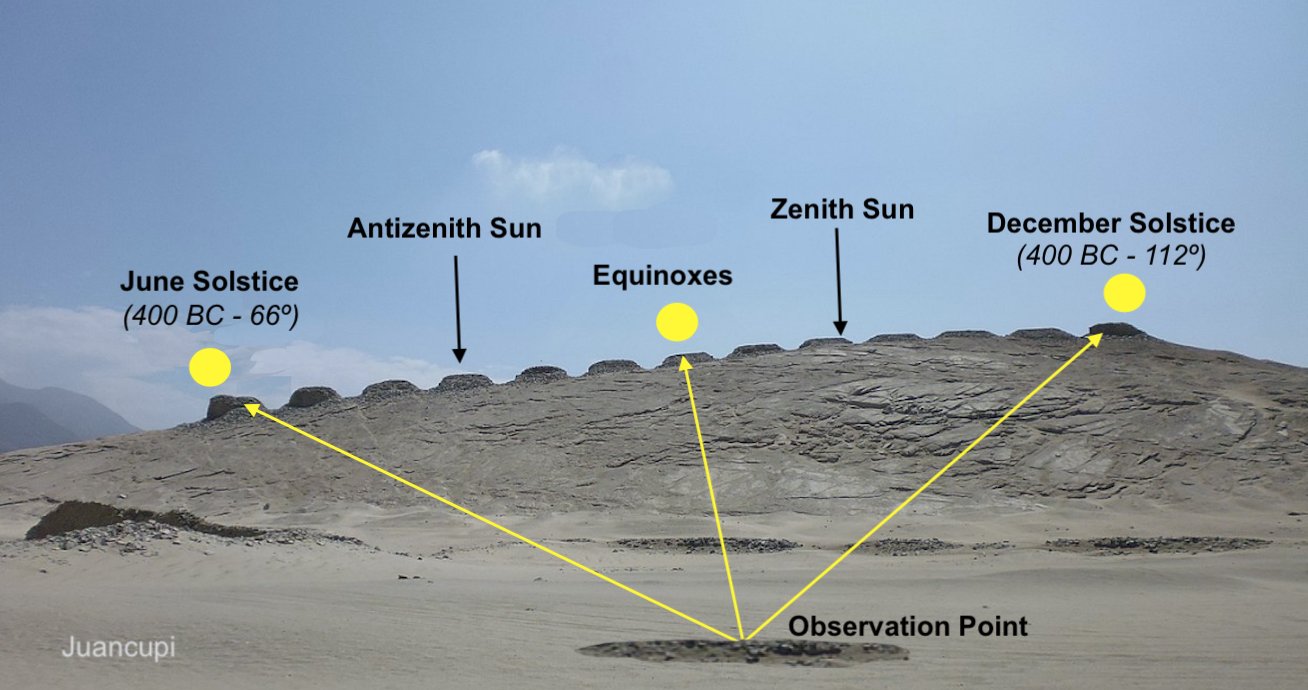BY UNESCO
The Chankillo Archaeoastronomical Complex is a prehistoric site (250-200 BC), located on the north-central coast of Peru, in the Casma Valley, comprising a set of constructions in a desert landscape that, together with natural features, functioned as a calendrical instrument, using the sun to define dates throughout the year.
The property includes a triple-walled hilltop complex, known as the Fortified Temple, two building complexes called Observatory and Administrative Centre, a line of thirteen cuboidal towers stretching along the ridge of a hill, and the Cerro Mucho Malo that complements the Thirteen Towers as a natural marker.
Aerial view of the Administrative complex Author: Ivan Ghezzi Copyright: © IDARQ
Chankillo Archaeoastronomical Complex is an outstanding example of ancient landscape timekeeping, a practice of ancient civilizations worldwide, which used visible natural or cultural features. Incorporated in the Thirteen Towers, it permitted the time of year to be accurately determined not just on one date but throughout the seasonal year. Unlike architectural alignments upon a single astronomical target found at many ancient sites around the world, the line of towers spans the entire annual solar rising and setting arcs as viewed, respectively, from two distinct observation points, one of which is still clearly visible above ground. The astronomical facilities at Chankillo represent a masterpiece of human creative genius.
Chankillo was in use for a relatively brief period of time between 250 and 200 BC, during a late phase of the Early Horizon Period (500-200 BC) of Peruvian prehistory, after which it was destroyed and abandoned. The Chankillo Complex is a very particular type of building representing an early stage in the development of native astronomy in the Americas. It shows great innovation by using the solar cycle and an artificial horizon to mark the solstices, the equinoxes, and every other date within the year with a precision of 1-2 days. The solar observatory at Chankillo is thus a testimony of the culmination of a long historical evolution of astronomical practices in the Casma Valley.
The Thirteen Towers Author: Ivan Ghezzi Copyright: © lDARQ
Integrity
All the elements necessary to express the Outstanding Universal Value of Chankillo Complex centred on calendrical observations of the sun are included within the property boundaries. Chankillo and the wider setting of related monuments that form the property take advantage of built and natural horizon markers to track the progressive passage of the sun along the horizon throughout the entire year. The natural environment and climatic conditions, that are the basis of the good visibility needed for astronomical observations at the site, are maintained to a large extent. The viewsheds that contain the main astronomical sightlines are generally unobstructed, but their preservation has to be monitored closely. Also, the visual integrity of the general setting of the property has to be maintained. Any infringement on the property by urban development or expansion of agricultural areas has to be avoided.
The advancing collapse of structural elements, with the loss of clear edges (e.g. at the tower buildings and the observatories), jeopardises the exactness of the astronomical observations. The conservation of monumental elements is fragile and needs to be closely monitored in the future. In case the information from future research indicates relationships of the central monuments with other elements of the property and beyond, a boundary adjustment should be considered.
View from inside the South Keep Author: Sergio Anchi Copyright: © IDARQ
Authenticity
The position of the Western and Eastern Observation Points in relation to the Thirteen Towers at Chankillo, identified by archaeological excavation and geophysical survey, and supported by archaeoastronomical data, suggests that the primary purpose of all these structures was to act together as a calendrical instrument. Since the 3rd century BC the sun has shifted slightly at and around the solstices, less at other times in the year. This small change has a negligible effect on the solar and possibly lunar alignments around the site but does not affect the ability of a present-day spectator to observe and understand the way in which the Chankillo functioned. Some aspects of the archaeoastronomical interpretations of the property may need further discussion. Since no invasive conservation and reconstruction campaigns have changed the material substance of the property, the conditions of authenticity in terms of material and form, are met.











